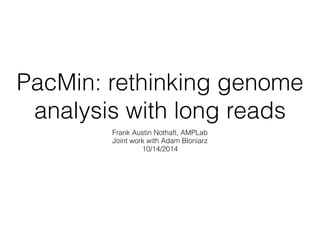PacMin @ AMPLab All-Hands
- 1. PacMin: rethinking genome analysis with long reads Frank Austin Nothaft, AMPLab Joint work with Adam Bloniarz 10/14/2014
- 2. Note: • This talk is mostly speculative. • I.e., the methods we’ll talk about are partially* implemented. • This means you have an opportunity to steer the direction of this work! * I’m being generous to myself.
- 3. Sequencing 101 • Most sequence data today comes from Illumina machines, which perform sequencing-by-synthesis ! ! ! • We get short (100-250 bp) reads, with high accuracy • Reads are (usually) paired http://en.wikipedia.org/wiki/File:Sequencing_by_synthesis_Reversible_terminators.png
- 4. Current Pipelines are Reference Based • Map subsequences to a “reference genome” • Compute variants (diffs) against the reference From “GATK Best Practices”, https://www.broadinstitute.org/gatk/guide/best-practices
- 5. An aside: What is the reference genome? • Pool together n individuals, and assemble their genomes together • A few problems: • How does the reference genome handle polymorphisms? • What about structural rearrangements? • Subpopulation specific alternate haplotypes? • It has gaps. 14 years after the first human reference genome was released, it is still incomplete.* * This problem is Hard.
- 6. The Sequencing Abstraction It was the best of times, it was the worst of times… It was the the best of times, it was worst of times the worst of • Sample poisson distributed substrings from a larger string • Reads are more or less unique and correct Metaphor borrowed from Michael Schatz best of times was the worst
- 7. …is a leaky abstraction • We frequently encounter “gaps” in the sequence Ross et al, Genome Biology 2013
- 8. …is a leakier abstraction • We preferentially sequence from “biased” regions: Ross et al, Genome Biology 2013
- 9. A very leaky abstraction! • Reads aren’t actually correct • >2% error (expect 0.1% variation) • Error probability estimates are cruddy • Reads aren’t actually unique • >7% of the genome is not unique (K. Curtis, SiRen)
- 10. The State of Analysis • We’re really good at calling SNPs! • But, we’re still pretty bad at calling INDELs, and SVs • And we’re also bad at expressing diffs • Hence, SMaSH! But really, reference + diff format need to be burnt to the ground and redesigned. • And, its slow. 2 weeks to sequence, 1 week to analyze. Not fast enough for practical clinical use.
- 11. Opportunities • New read technologies are available • Provide much longer reads (250bp vs. >10kbp) • Different error model… (15% INDEL errors, vs. 2% SNP errors) • Generally, lower sequence specific bias Left: PacBio homepage, Right: Wired, http://www.wired.com/2012/03/oxford-nanopore-sequencing-usb/
- 12. If long reads are available… • We can use conventional methods: Carneiro et al, Genome Biology 2012
- 13. But! • Why not make raw assemblies out of the reads? Find overlapping reads Find consensus sequence for all pairs of reads (i,j): i j =? …ACACTGCGACTCATCGACTC… • Problems: 1. Overlapping is O(n 2 ) and single evaluation is expensive anyways 2. Typical algorithms find a single consensus sequence; what if we’ve got polymorphisms?
- 14. Fast Overlapping with MinHashing • Wonderful realization by Berlin et al1: overlapping is similar to document similarity problem • Use MinHashing to approximate similarity: 1: Berlin et al, bioRxiv 2014 Per document/read, compute signature:! ! 1. Cut into shingles 2. Apply random hashes to shingles 3. Take min over all random hashes Hash into buckets:! ! Signatures of length l can be hashed into b buckets, so we expect to compare all elements with similarity ≥ (1/b)^(b/l) Compare:! ! For two documents with signatures of length l, Jaccard similarity is estimated by (# equal hashes) / l ! • Easy to implement in Spark: map, groupBy, map, filter
- 15. Overlaps to Assemblies • Finding pairwise overlaps gives us a directed graph between reads (lots of edges!)
- 16. Transitive Reduction • We can find a consensus between clique members • Or, we can reduce down: • Via two iterations of Pregel!
- 17. Actually Making Calls • From here, we need to call copy number per edge • Probably via Newton-Raphson based on coverage; we’re not sure yet. • Then, per position in each edge, call alleles: Notes:! Equation is from Li, Bioinformatics 2011 g = genotype state m = ploidy 휖 = probability allele was erroneously observed k = number of reads observed l = number of reads observed matching “reference” allele TBD: equation assumes biallelic observations at site and reference allele; we won’t have either of those conveniences…
- 18. Output • Current assemblers emit FASTA contigs • In layperson’s speak: long strings • We’ll emit “multigs”, which we’ll map back to reference graph • Multig = multi-allelic (polymorphic) contig • Working with UCSC, who’ve done some really neat work1 deriving formalisms & building software for mapping between sequence graphs, and GA4GH ref. variation team 1. Paten et al, “Mapping to a Reference Genome Structure”, arXiv 2014.

















